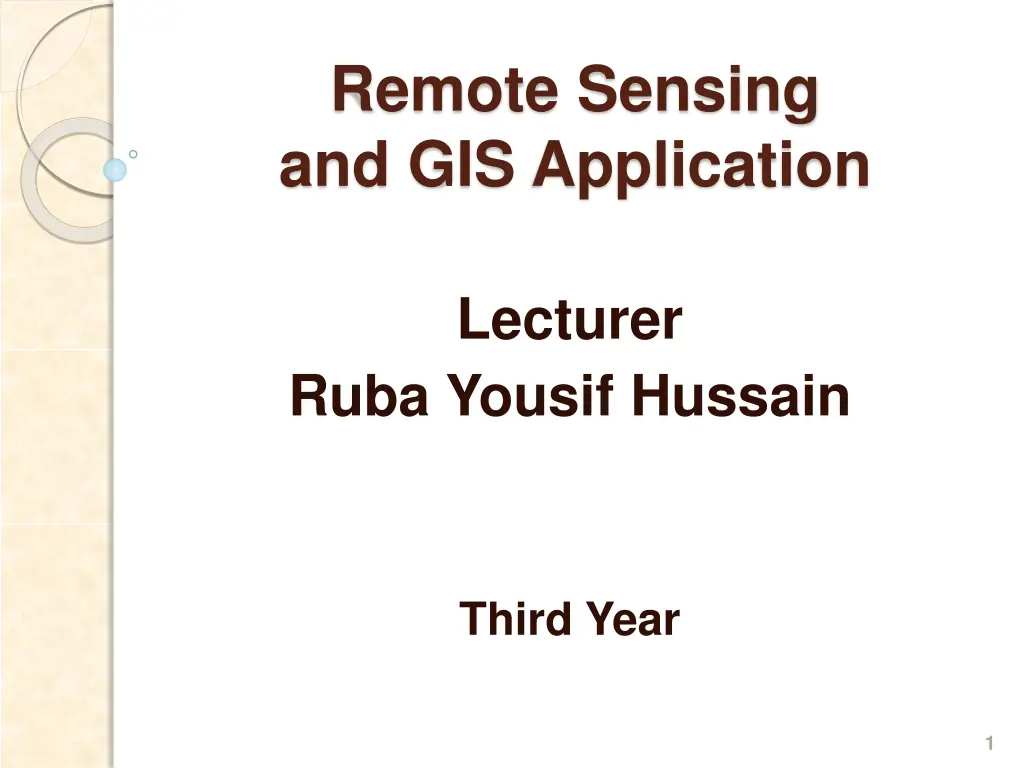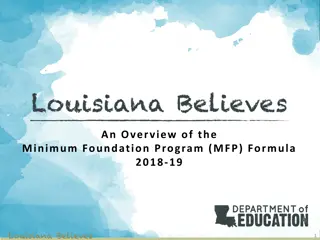
Image Rectification and Restoration in Remote Sensing and GIS
"Learn about image rectification and restoration techniques in remote sensing and GIS applications, including geometric and radiometric correction, as well as noise removal. Explore the process of georeferencing to assign map coordinates to image data for spatial accuracy."
Download Presentation

Please find below an Image/Link to download the presentation.
The content on the website is provided AS IS for your information and personal use only. It may not be sold, licensed, or shared on other websites without obtaining consent from the author. If you encounter any issues during the download, it is possible that the publisher has removed the file from their server.
You are allowed to download the files provided on this website for personal or commercial use, subject to the condition that they are used lawfully. All files are the property of their respective owners.
The content on the website is provided AS IS for your information and personal use only. It may not be sold, licensed, or shared on other websites without obtaining consent from the author.
E N D
Presentation Transcript
Remote Sensing and GIS Application Lecturer Ruba Yousif Hussain Third Year 1
Remote Sensing and GIS Application Lecturer Third Year Ruba Yousif Hussain Image Rectification and Restoration The intent of image rectification and restoration is to correct image data for distortions or degradations that stem from the image acquisition process. These operations are treated under the generic headings of geometric correction , radiometric correction , and noise removal . Geometric Correction The sources of these distortions range from Variations in the altitude Attitude Velocity of the sensor platform to factors such as Panoramic distortion Earth curvature Atmospheric refraction Relief displacement Nonlinearities in the sweep of a sensor's IFOV ( Instantaneous Field of View ) . The intent of geometric correction is to compensate for the distortions introduced by these factors so that the corrected image will have the highest practical geometric integrity. The geometric correction process is normally implemented as a two step procedure : 1- Systematic or Predictable distortions are corrected by applying formulas derived by modeling the sources of the distortions mathematically. 2- Random or Unpredictable and residual unknown systematic distortions are corrected by analyzing well-distributed ground control points ( GCPs ). 2
Remote Sensing and GIS Application Lecturer Third Year Ruba Yousif Hussain Radiometric correction The radiance measured by any given system over a given object is influenced by such factors as 1. changes in scene illumination 2. atmospheric conditions 3. viewing geometry 4. instrument response characteristics Corrections 1. sun elevation correction 2. earth-sun distance correction Noise removal Image noise is any unwanted disturbance in image data that is due to limitations in the sensing , signal digitization , or data recording process. Noise removal usually precedes any subsequent enhancement or classification of the image data. Noise is either systematic ( periodic ) , random , or some combination of the two. systematic ( destriping , line drop ) random ( bit errors ) 3
Remote Sensing and GIS Application Lecturer Third Year Ruba Yousif Hussain Typical noise correction algorithm DN1 DN2 DN3 DN4 DN5 DN6 DN7 DN8 DN9 AVEA AVEB = ( DN2 + DN4 + DN6 + DN8 ) / 4 DIFF = AVEA - AVEB THRESH = DIFF WEIGHT = ( DN1 + DN3 + DN7 + DN9 ) / 4 IF : DN5 - AVEA or DN5 - AVEB > THRESH THEN : DN 5 = AVEB OTHERWISEDN 5 = DN5 4
Remote Sensing and GIS Application Lecturer Third Year Ruba Yousif Hussain Georeferencing Georeferencing refers to the process of assigning map coordinates to image data. The control points are used to build a polynomial transformation that will convert the raster dataset from its existing location to the spatially correct location. The connection between one control point on the raster dataset and the corresponding control point on the aligned target data is a link. The number of the non correlated control points required for this method must be 1 for a zero-order shift, 3 for a first order affine, 6 for a second order, and 10 for a third order. The first-order polynomial transformation is commonly used to georeference an image. Below is the equation to transform a raster dataset using the affine (first order) polynomial transformation. You can see how six parameters define how a raster's rows and columns transform into map coordinates. = + + .........( ) 1 x Ax By C = + + .......... ..( ) 2 y Dx Ey F 5
Remote Sensing and GIS Application Lecturer Third Year Ruba Yousif Hussain Image space and coordinate space Where : x is the column count in image space y is the row count in image space x' is the horizontal value in the coordinate space y' is the vertical value in the coordinate space A is the width of cell in map units B is the rotation term C is the x' value of the center of upper-left cell D is a rotation term E is negative of height of cell in map units. F is the y' value of the center of the upper-left cell 6
Remote Sensing and GIS Application Lecturer Third Year Ruba Yousif Hussain Laboratory Georeferencing Purpose Georeference an image or a map in Arcmap Application ArcGIS Data Image or Map Coordinate Table Tutorial 1. Click the View Link Table button on the Georeferencing toolbar. 2. Click the Add Control Points tool . 3. Click a known location in the unreferenced image to add the first coordinate in the link. 4. Right-click the image and click Input X and Y. 5. Type the reference coordinates on the Enter Coordinates dialog box. 6. Click OK. Georeferencing Toolbar The Georeferencing toolbar is used to georeference raster and CAD data. 7
Remote Sensing and GIS Application Lecturer Third Year Ruba Yousif Hussain 8
Remote Sensing and GIS Application Lecturer Third Year Ruba Yousif Hussain 9
Remote Sensing and GIS Application Lecturer Third Year Ruba Yousif Hussain 10






















